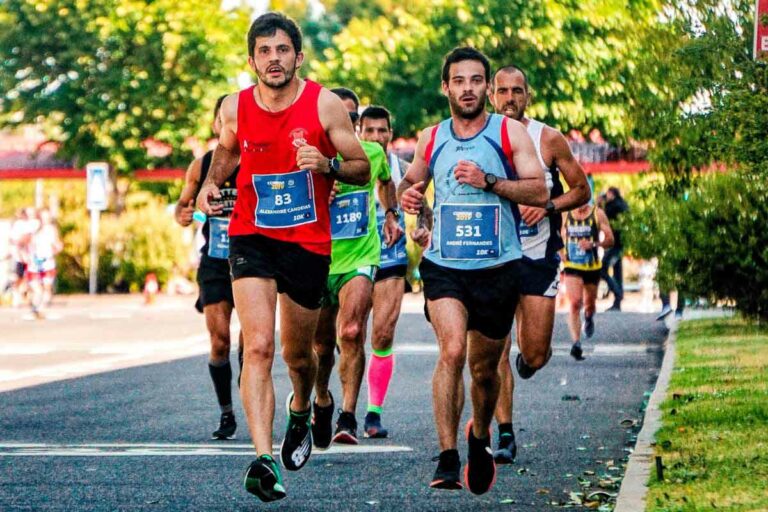How to Run Your First 100K – And How To Train & Prepare

Running a 100K is no simple undertaking, and even the most experienced runners require some form of training in the run-up to the big day.
This can come in many forms, be it a new exercise routine, improving stamina, eating a healthier diet, and altering your sleep schedule to get more rest, and all of them are important to get the most from the 100K.
Whilst there is no indication as to what could happen on race day, making some of these changes will give you the best chance of going the distance.
What Is 100K?
This might not seem like it would be much, but don’t let the kilometers fool you, 100K is equivalent to 62.14 miles.
This is around 2.5 times more than the length of a standard marathon, just to put it in perspective. Running races longer than marathons are called ultramarathons.
To prepare for such an extreme ultramarathon experience, distinct changes must be made to the body and mind.
100K: How To Train & Run
You might think you can just extrapolate your existing marathon training regime and apply it to a 100K run, but that simply isn’t true.
The reality is that a great deal of conditioning is required to prepare you – all while avoiding overexercising and harmful regimens that could cause you setbacks and injuries.
Time On Your Feet
There are no two ways about it – running 100K will take you a long time.
This means that you will be on your feet for a long time, something that despite sounding easy in principle, will soon feel like a torturous state of affairs when you are several miles into the run.
This means that it is beneficial to get used to long periods of running, and whilst there is no specific plan that will achieve this, it is recommended to do a few runs that are at least 50K – just to condition you as much as possible.
Body Strengthening
To run 100K, you need endurance, and the best way to do this is to increase the strength and stamina of your muscles.
Whilst many runners can manage shorter marathons with simple running training, ultramarathons like the 100K require greater strength throughout the rest of your body to reinforce yourself against fatigue and exhaustion.
The most important areas to work on are your core muscles, and upper legs.
This is the best way to help you stay on your feet for several hours, and give you the proper tools to help you push forward through the tiredness.
Also, bear in mind that your entire body is working when you are running, not just your legs.
This means that general strength training a couple of times a week can be beneficial to improving your overall strength and flexibility.

Long Runs
Engaging in long runs can be a great way to get you ready for the big day, and can teach you a lot about pacing yourself, establishing good breathing patterns, and ensuring proper hydration schedules.
These should be built up in smaller increments and should reach as far as at least 50K – pushing as far as 70 or 80K if possible.
The more used to running these high distances the better, as this will make the 100K seem like less of a shock to the system when the time comes.
However, the best ways to do these runs are slow and steady, after all as the saying goes, it is a marathon, not a sprint.
Tapering Your Training
This is a tried and tested training technique, which involves you increasing your exercise and preparation between 2-4 weeks prior to the 100K.
This should be done incrementally and will help to reduce the overall shock on your body when the main event comes.
Tapering should depend entirely on how fit you are.
If you are a frequent long-distance runner, then you shouldn’t require too much work, however, if you are fairly new to the ultramarathon scene, then tapering could make all the difference.
Choose Achievable Races
If it is indeed your first time, then it might be advisable to choose a 100K that is as flat as possible.
Avoid rugged and uneven terrain, and try to avoid races with inclines, as these will add a whole new level of difficulty to your experience.
Proper Exertion
If you are in the first 30-40K of the race and you feel as though you are really pushing yourself, then you are running too fast.
With proper pacing and rates of exertion, you can save yourself for the final stretch and expel minimal energy during the initial stages.
Proper Sleep Patterns
Aside from exercise, it is also important to establish and adhere to a proper sleep schedule.
When you exercise, your body goes through a lot of wear and tear, especially your muscles, and it is during sleep that most of our body’s repairs take place.
The better pattern you are in, the more efficient your body will be at repairing damage, ensuring you feel as fresh and energized as possible after every workout.
Eating A Balanced Diet
The foundation of any exercise regimen starts in the kitchen and eating a balanced diet full of protein, nutrients, minerals, and vitamins will help turn your body into a well-oiled machine for race day.
This will also aid sleep, and give your body the tools it needs to properly heal tissue, replenish energy, and develop proper levels of endurance – all of which will come in handy when running 100K.
The Bottom Line
And there we have it, everything you need to know about running 100K and the training needed to get you there.
With the proper pacing, planning, training, diet, and lifestyle, you will have what you need to take the distance of 100K on an easy course. But running these toughest ultramarathons is the ultimate challenge for even the fittest athletes!






